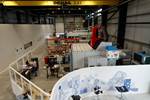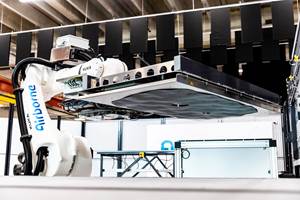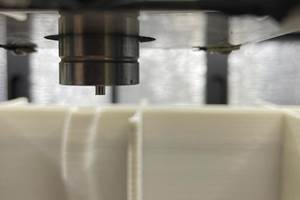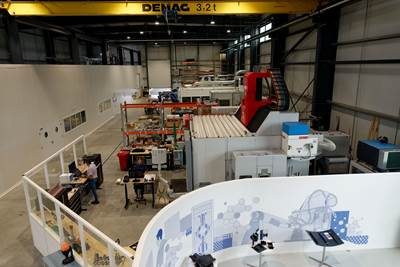NRL’s robot predicts how composites will perform in large aircraft
As private companies and the military continue to look to advanced composites for new aerospace and other applications, NRL's robot may help get aircraft from factory to fleet faster.
Share
Read Next
The U.S. Naval Research Laboratory (NRL) has built a robot to pull, bend and twist samples of the composite materials used to build F/A-18s and other aircraft, according to a new report from the NRL.
The F/A-18 Hornet became the U.S. Navy and Marine Corps' first strike fighter in 1978 and the median age of today's active aircraft is 22-23 years old. As F/A-18s continue to age beyond their design life cycle, showing structural stress corrosion cracking and wing panel composite skin abnormalities, engineers have had to do extensive analysis to develop repairs. This is where the need to certify a new material comes in.
Today, the Department of Defense (DoD) uses a "building-block approach" from 1999, as set out in the Composite Materials Handbook-MIL 17. The approach starts with testing fibers and matrix materials. However, the tests get, as the handbook states, "increasingly more complicated," until reaching the level of structural subcomponent (or higher).
"I can tell you that qualifying the system for the F/A-18 took about 13,000 specimens and about 18 years,” said John Michopoulos, group leader of the NRL project. "Engineers are forced to conduct tests at multiple scales because they do not really have a theory to connect the behavior across multiple scales."
As private companies and the military continue to look to advanced composites for new aerospace and other applications, NRL's robot could help get aircraft from factory to fleet faster.
Named NRL66.3, the robot is a "multiaxial loading machine." It has six devices that apply linear movement, termed actuators, in a hexapod configuration. While a material sample is held by a fixed grip from one end, the actuators move a grip that holds the other end of a material sample, moving it in any combination of up to three translations and three rotations. So the robot can "apply combinations of tension or compression, bending, and torque simultaneously," Michopoulos said.
The NRL66.3 is fully automated. Assisted by two other robots, it will take 72 specimens of the material used in part of an F/A-18, and apply 72 loading paths in that six-dimensional space. The robot loads each specimen until it snaps, then quickly moves onto the next. A custom-developed machine vision system, with four cameras, captures digital images of what's happening in real-time.
While the experiment is going on, the scientists use custom-developed full field measurement algorithms Michopoulos' group has now patented to "take those digital images and analyze them, and convert them to displacement and strain fields."
What the experiments do is to, very quickly, capture what might happen to an advanced composite in the real world. Advanced composites age in a very particular way. "The resin that's between the fibers starts developing little micro-cracks," says Michopoulos, which can cause the resin to separate from the fibers or the fibers to break. "A continuous accumulation of micro-cracking (that leads to a softening of the material) can be used as a metric for material degradation assessment."
The group has, over the past 20 years, used various robots to test more than 150 different material systems, with potential applications for ballistic missiles to rocketry to automobile manufacturing.
Related Content
Modular, robotic cells enable high-rate RTM using any material format
Airborne’s automated ply placement systems at Airbus, GKN Aerospace and Teijin Automotive Technologies aim to maximize flexibility and intelligent automation.
Read MoreTAVieDA project team cuts aircraft door production time using thermoplastic composites, welding
Fraunhofer groups, Trelleborg and Airbus develop modular, fully automated assembly system concept to replace metals and time-consuming assembly that shows potential for scalability.
Read MoreACoSaLUS project develops fully automated FPP layup for legacy sandwich parts
Joint R&D project results show 7 times improvement in layup rates, reduced material deployment and development of novel layup features when using FPP for aerospace production.
Read MoreMold 3D printing helps automate composite bathtub, shower production
As part of its efforts to automate as much of its production process as it can, Lyons Industries acquired a Massivit 10000 additive manufacturing system to quickly produce high-performance molds and support fixtures.
Read MoreRead Next
All-recycled, needle-punched nonwoven CFRP slashes carbon footprint of Formula 2 seat
Dallara and Tenowo collaborate to produce a race-ready Formula 2 seat using recycled carbon fiber, reducing CO2 emissions by 97.5% compared to virgin materials.
Read MorePlant tour: Daher Shap’in TechCenter and composites production plant, Saint-Aignan-de-Grandlieu, France
Co-located R&D and production advance OOA thermosets, thermoplastics, welding, recycling and digital technologies for faster processing and certification of lighter, more sustainable composites.
Read MoreAssembling the Multifunctional Fuselage Demonstrator: The final welds
Building the all-thermoplastic composite fuselage demonstrator comes to an end with continuous ultrasonic welding of the RH longitudinal fuselage joint and resistance welding for coupling of the fuselage frames across the upper and lower halves.
Read More













